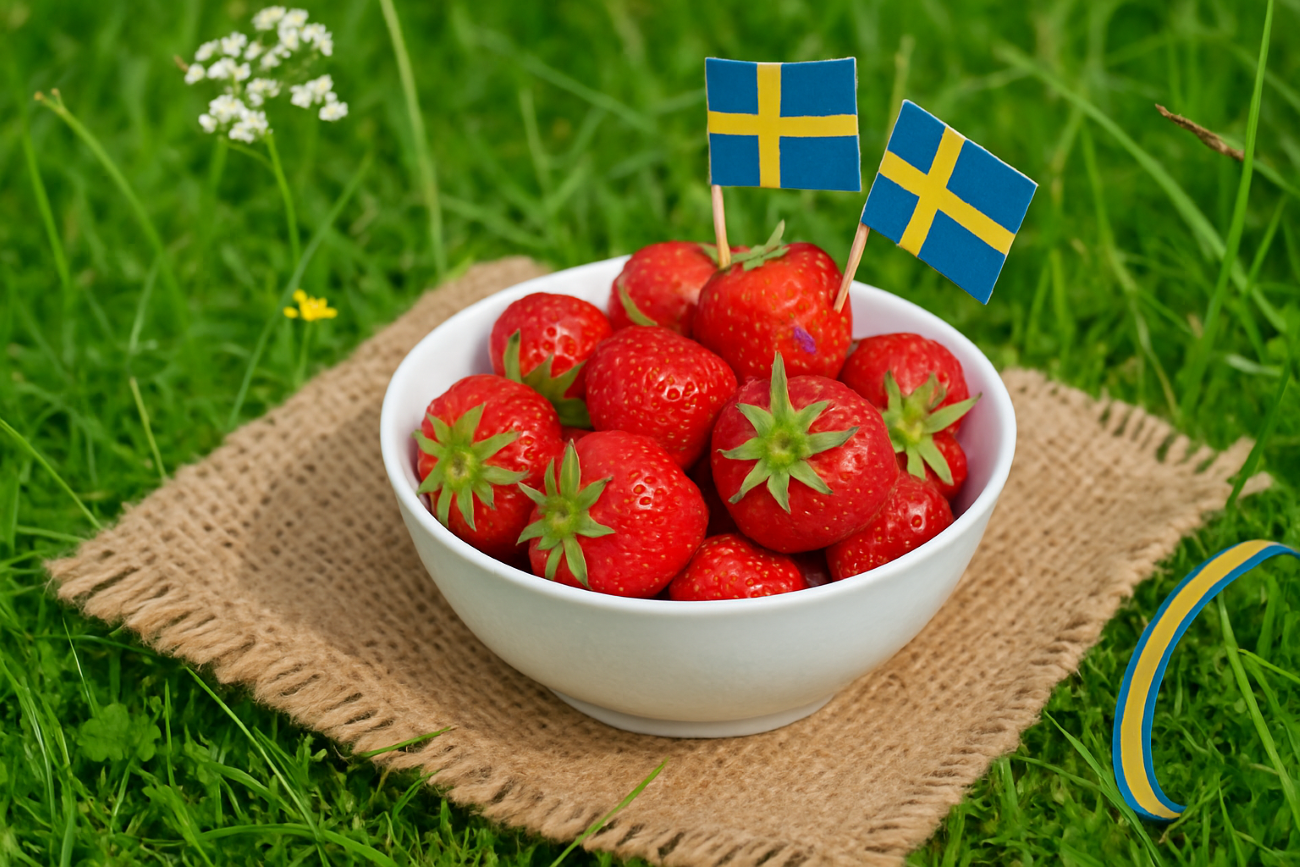Det finns ett ögonblick, precis runt midsommar, när hela Sverige liksom håller andan. Himlen blir mjukt rosa någon gång efter klockan tio på kvällen. Barn springer barfota i gräset. Och någon viskar:
"Jag hörde att jordgubbarna är här."
Svenska jordgubbar är inte bara frukt. De är en säsong. En händelse. Ett rött, saftigt bevis på att solen faktiskt kom tillbaka. Att det äntligen är okej att sakta ner. Och att fika numera – officiellt – inkluderar vispad grädde.
Vi har sett dem ligga som rubiner på Hötorgets marknadsstånd. I små handskrivna kartonger hos frukt- och gröntbutiken på hörnet i Vasastan. Och ja – vi har stått i kö för en enda pappask, fortfarande ljummen av solen, doftande av regn, jord och någonting som bara kan beskrivas som ren svensk sommar.
De är små. De blir lätt mosade. Men smaken? Den är där. Djup, blommig, intensiv. En sån bärsmak som inte behöver något mer. Kanske en sked. Kanske inte. Det är som om en mormor har målat dem med socker och solljus.
Inte “Instagram-röd”.
Riktig röd.
Tekniskt sett är jordgubben ingen riktig bär – utan en så kallad skenfrukt. Det där röda? Det är en uppsvälld blombotten. Och de små prickarna på utsidan? Det är de faktiska frukterna. Men vet du vad? Vi bryr oss inte. För i Sverige är jordgubben en känsla. Och smaken kommer från att den inte har transporterats. Inte plastats in. Inte legat i kylrum i dagar. Den är plockad här. Äten här. Direkt.
Sorterna är ofta Polka, Korona, Zephyr. De är lokala, känsliga, och helt perfekta i ungefär fem minuter. Vilket är precis som vi vill ha det.
Du äter dem på en brygga. I en park. På motorhuven i en ICA-parkering. Knappast sköljda. Fortfarande lite jordiga. Fortfarande lite vilda. För om två veckor? Då är de borta.
Och även om vi älskar våra svenska bär, så finns det en plats i hjärtat för de sydeuropeiska kusinerna. I Italien dyker fragole upp i mars. Ljusröda, doftande, ofta serverade med citronjuice och socker. I vissa regioner hälls ett stänk rött vin över. Och i barndomens italienska hem? Då handlade söndagar om tunt skivade jordgubbar, lite citron, lite socker – och sen scarpetta: brödet som suger upp den sista röda sirapen från tallrikens botten.
I Emilia-Romagna badade de i Lambrusco. I Neapel toppade de ricottatårtor. Överallt fanns det en nonna med en trädgårdslott som vaktades som ett Fort Knox. Men till och med italienarna erkänner: de svenska jordgubbarna äger sommaren. Det är inte ens en tävling.
Och nu tänker du: jordgubbar och lasagne?
Ja. Faktiskt. Häng med nu.
Vi har alltid sagt: livet består av lager. Och sommaren är inget undantag.
Lager ett: solbrända axlar.
Lager två: någon grillar i bakgrunden.
Lager tre: kall lasagne, direkt ur kartongen med en gaffel.
Lager fyra: dessert. Alltid dessert.
Efter en rejäl bit vegetarisk sommar-lasagne från Lasagnariet – med grillad zucchini, citron-béchamel och hemgjorda pastaplattor – kommer du att vilja ha något sött. Något som inte diskuterar. Något som bara säger: du klarade vintern. Du är fantastisk.
Där kommer vår jordgubbssås in i bilden. Gjord på färska svenska bär, lite apelsinzest och precis så mycket socker som får smaken att explodera. Eller inget socker alls – vi dömer ingen. Det är svensk sommar på sked.
Och du som vuxit upp här, du vet redan hur det går till. En moster, solkräm, och Tupperware. “En i munnen, två i lådan.” Ljug. Du åt fler än du plockade. Fick jordgubbsröda fingrar. Brände dig i nacken. Kom hem med halv korg. Helt nöjd.
Är du ny till traditionen? Så här funkar det:
Du hittar en gård. Helst en där bonden har starka väderåsikter.
Du tar med en korg. Den är alltid för liten.
Du plockar. Du smakar. Du plockar mer.
Du betalar kontant.
Du äter hälften i bilen på vägen hem.
Självplock finns överallt runt Stockholm – Ekerö, Tyresö, Sigtuna. Men orkar du inte? Ingen fara. Vi har redan gjort jobbet åt dig – och lagt det i en rätt.
För vi krånglar inte till det. Vi gillar hemlagad mat, gjord från grunden, att dela med någon man tycker om.
Här är vårt förslag på en somrig picknick eller balkongmiddag:
Börja med en krispig sallad: grön sparris, jordgubbar, ruccola, mynta, balsamico och lite svartpeppar. Ovant? Ja. Fantastiskt? Också ja.
Huvudrätten: en bit vegetarisk lasagne, serverad kall med citronolja och färsk ruccola. Eller så tar du en klassisk Lasagna Bolognese – för varför inte? Ragù har ingen årstid.
Till dryck: kombucha med bubblig syra, eller ett glas kallt Prosecco. Livet är kort.
Och efteråt? Färska jordgubbar. Rå coulis. Krossad maräng. En klick chantillygrädde.
Det är komfortmaten när den är som bäst.
Hemligheten bakom smaken? Tålamod.
Säsongen är kort. Jordgubbarna gör inte reklam. De bara dyker upp. Stannar ett ögonblick. Försvinner. Det är därför vi älskar dem. Vi jagar dem, äter dem med händerna, drömmer om dem i januari. Precis som en riktigt bra lasagne – de går inte att stressa fram.
Du tar dig tid. Du använder det som växer just nu. Du låter smakerna tala.
Och när det är riktigt bra, så tänker du:
“Det här är vad sommaren smakar.”
Så den här veckan firar vi jordgubben.
Ärlig. Lokal. Smakrik – men inte för söt.
Precis som vi.
Från köket med kärlek,
Lasagnariet

